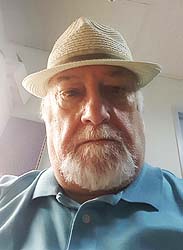 Prof. Grabowski: “Polska dyplomacja zaangażowała się w nacjonalistyczny Kulturkampf”
Prof. Grabowski: “Polska dyplomacja zaangażowała się w nacjonalistyczny Kulturkampf”
Katarzyna Markusz
 Prof. Jan Grabowski, fot. archiwum prywatne
Prof. Jan Grabowski, fot. archiwum prywatne
Partia rządząca Polską coraz śmielej daje do zrozumienia nie tylko politykom, ale i dziennikarzom, że nie powinni zajmować się tematami trudnymi i niewygodnymi, które godzą w dobre samopoczucie Polaków przekonanych o swojej wyjątkowości i bohaterskiej przeszłości. O podejmowanych w związku z tym przez polskie władze działaniach rozmawiamy z prof. Janem Grabowskim z Uniwersytetu w Ottawie.
Przedstawiciel IPN gościł we wtorek na Uniwersytecie w Ottawie, gdzie mówił o Polakach ratujących Żydów w czasie wojny. Przyjechał tam, żeby skonfrontować się z Tobą i Twoimi badaniami?
IPN został wyposażony – za pieniądze polskiego podatnika – z państwowego budżetu, w ogromne środki. Jeżeli chodzi o działania za granicą, to promowanie “łatwej” wersji historii Polski, w wersji “light”, stało się swoistym artykułem eksportowym IPN. Bez wątpienia najważniejszym produktem w serii “light” przeznaczonym na eksport jest historia Zagłady – jakkolwiek okropnie może to zabrzmieć.
Młody człowiek, którego wydelegował na mój uniwersytet IPN, po pierwsze, miał niewiele do powiedzenia, po drugie – nie umiał mówić po angielsku, wobec czego dwudziestominutowy speech był do zniesienia, lecz nie do zrozumienia. Krótko mówiąc, była to kompromitacja, jakiej od dawna u nas nie widziano, ale po tym wykładzie IPN pozostawił na terenie uniwersytetu równie kompromitującą wystawę. Na trzydziestu ogromnych (2 metry na 1 metr) planszach można przeczytać o Polakach ratujących Żydów. Samych Żydów zresztą prawie wcale tam nie widać, ale to w końcu nie Żydzi, a Polacy są tu istotni.
A co jest na tych planszach?
Na planszach widać zdjęcia sprawiedliwych Polaków, trochę dokumentów itp. Ogólny przekaz jest jasny: podczas okupacji Polacy ratowali Żydów z zapałem, z poświęceniem, ofiarnie i gromadnie. Na jednej, jedynej, planszy jest wzmianka o tym, że zdarzały się też wypadki denuncjacji, jest nawet parę donosów, ale zaraz poniżej – uspokajająco – pojawiają się zdjęcia wyroków sądów podziemnych na szmalcownikach. Tego, że szmalcowników zlikwidowanych na podstawie wyroków sądów podziemnych można zliczyć na palcach obu rąk – jakoś na wystawie nie widać. Groteskowo wygląda informacja o tym, że po wojnie ratujący i ratowani pozostawali w miłych kontaktach i że Żydzi dosyłali ratującym paczki zza granicy. Ale dlaczego ci Żydzi znaleźli się nagle za granicą – o tym już się niczego nie dowiemy. Nie dowiemy się też jak wyglądało powitanie wychodzących z ukrycia Żydów. A kulminacja tego powitania nastąpiła przecież 4 lipca 1946 roku w Kielcach. Lecz o tym, rzecz jasna, na wystawie IPN słowa nie ma.
Korzystając z tego, że mamy ostatnie dni zajęć przed przerwą świąteczną, przeniosłem wykład dla studentów trzeciego roku właśnie pod wystawę IPN-u i – w ciągu ponad godziny – wyjaśniałem im jak można zniekształcać przekaz historyczny, na czym polega szyta grubymi nićmi propaganda historyczna, jak można półprawdy podawać jako całą prawdę i jak można budować na fałszu mity narodowej niewinności. I jak wielką groźbę niosą ze sobą słowa Orwella: “Who controls the past controls the future. Who controls the present controls the past”. Co więcej, jak się dowiedziałem, w tym samym celu na wystawie pojawili się moi koledzy i koleżanki z wydziału, którzy wykładają metodologię historii. No bo trudno o bardziej jaskrawy przykład pogwałcenia podstaw metodologicznych naszej dziedziny wiedzy. A tu jeszcze dostarczono nam wystawę loco domo, że się tak wyrażę.
Czy w Polsce istnieje dziś pełna wolność badań naukowych?
Jeżeli chodzi o pracę w instytucjach typu IPN – to na pewno nie. O czym przekonali się na własnej skórze niektórzy moi koledzy i znajomi zajmujący się historią stosunków polsko-żydowskich. Bo to właśnie na tym odcinku obsesje historyczne polskich nacjonalistów wychodzą najjaskrawiej. Jeżeli chodzi o duże uniwersytety, to nie widzę na razie bezpośredniego zagrożenia dla wolności badań, jest to zwarte środowisko, które potrafi – jak na razie – opierać się naciskom i bronić wartości bliskich sercu każdego badacza. Dużo trudniejsza jest sytuacja ludzi w mniejszych ośrodkach, tam, gdzie władza znajduje się dużo bliżej obywatela niż np. w Warszawie.
Tym jednak co wzbudza moje największe obawy, jest przyszłość i kierunki rozwoju badań. Już teraz widać efekt mrożący “polskiej ustawy o Holokauście” – jak w świecie określa się nowelizację ustawy o IPN. Na spotkaniach z nauczycielami (a odbywam ich co roku wiele w Polsce) dowiaduję się o presjach wywieranych przez kuratoria i dyrekcje, których celem jest wzmocnienie “postaw patriotycznych” – postaw rozumianych w najbardziej prymitywny, tryumfalistyczny sposób – wśród młodzieży. Podczas niedawnego cyklu wykładów, który miałem w Krakowie, sporo czasu spędziłem na rozmowach z młodymi historykami, którzy – poszukując własnego pola badawczego – od razu zastrzegli się, że w te bardziej delikatne i najmniej znane tematy iść nie będą.
Politycy chcą wpływać na to co mówimy i piszemy?
Oczywiście. Dla nacjonalistów rządzących dziś Polską, historia, czy też raczej ich wizja narodowej przeszłości, to punkt centralny projektu wychowania nowego pokolenia. Tego powinniśmy się niesłychanie bać. Kiedy czytam o setkach milionów złotych, które idą dziś na budowę muzeów ”pozytywnej narracji” – na różne koszmarne projekty muzealne Rydzyka, na Muzeum Historii Polski, na muzeum Żołnierzy Wyklętych, na muzeum w Markowej, na dekonstrukcję Muzeum II Wojny Światowej, na muzeum “miłości polsko-żydowskiej“, jak ładnie określił minister Gliński planowane muzeum getta warszawskiego – to się robi bardzo nieprzyjemnie. A jak sobie zajrzymy do podręczników szkolnych to, jak już wspomniałem, grozą wieje. Także nie powinno nas dziwić, że połowa (!) polskiej młodzieży gimnazjalnej dziś twierdzi, że w Jedwabnem, w stodole, Niemcy spalili Polaków ukrywających Żydów!
Ale za tę sytuację nie odpowiada jedynie obecnie rządząca partia.
Rząd dusz, jaki zdają się w Polsce dziś sprawować nacjonaliści spod znaku dalekiej prawicy, nie wziął się znikąd. Mam tu ogromny żal do poprzednich, demokratycznych, rządów, które w części oddały historię w pacht ekstremistom, a w części – tę wizję narodowej przeszłości po prostu podzielały. W tym marszu samozadowolenia narodowego szła w końcu większa część polskiego społeczeństwa – a wyrazem tego był były prezydent Komorowski, nieudolnie i nieporadnie próbujący obchodzić nacjonalistów z prawej strony, kłaniając się Dmowskiemu oraz “żołnierzom wyklętym”. Pamiętam też moją rozmowę z byłą minister kultury, dla której Zagłada polskich Żydów wydawała się być kukułczym jajem złośliwie podrzuconym Polakom przez Niemców. Byłem tym wstrząśnięty.
To, co się dzieje dziś nie powinno nas dziwić; to efekt lat ciężkiej pracy i ciężkich zaniedbań. Polska jest dziś krajem tonącym w biało czerwonych flagach, upstrzonym pomnikami własnej wielkości, a zarazem miejscem, gdzie nie ma ani jednej instytucji zajmującej się dziejami Zagłady (proszę nie mówić, że jest nią kilkuosobowe i oparte o wolontariat Centrum Badań nad Zagładą IFiS PAN, którego jestem członkiem!), gdzie nie ma ani jednej katedry historii Zagłady i gdzie nie ma ani jednego muzeum Zagłady! W kraju, któremu wymordowano z klucza rasowego 10% ludności….w kraju, w którym wymordowano ponad 98% ludności żydowskiej….
Niedawno operatora TVN próbowano oskarżyć o propagowanie faszyzmu, bo brał udział w przygotowaniu materiału na temat polskich neo-faszystów. Dla wielu to jednoznaczna próba zastraszenia dziennikarzy, którzy podejmują trudne tematy. Politycy nie mogą powstrzymać się przed krytykowaniem mediów. Mnie samą w mediach społecznościowych krytykował ambasador Polski w Szwajcarii, doradca premiera (który pod moimi artykułami w zagranicznych mediach pisał “fake news”), a nowy ambasador Polski w Izraelu porównał mnie do “lekarza, który źle leczy”. Naciski na badaczy, naciski na media. Jak się przed tym bronić?
Zastraszanie dziennikarzy staje się jednym z coraz to częściej widzianych sposobów działania polskich władz. Widać dziś, że polskie państwo nie tylko ma kły, ale że lubi je odsłaniać. Zaangażowanie zaś polskiej dyplomacji w nacjonalistyczny Kulturkampf jest czymś czego doświadczam na własnej skórze nie od dziś. Jeżeli urzędnicy polskiego MSZ, będący dyletantami na polu historii, ważą się karcić i pouczać profesorów historii, to wyobrażam sobie jak śmiało mogą sobie poczynać wobec dziennikarzy. Jak sobie z tym radzić? Przenosząc walkę na pole przeciwnika, wyciągając ich kłamstwa i półprawdy z mroku, pisząc o tym jak najwięcej. Ostatnio czytałem w OKO press dobrze napisaną “dekonstrukcję” dyskursu polskiego ambasadora w Izraelu. Szkoda tylko, że na to człowiek marnuje czas, który można by o wiele lepiej spożytkować.
Co musiałoby się stać, żebyśmy wszyscy zaczęli o tej historii rzetelnie rozmawiać?
Od lat nawołuję – z dość mizernym skutkiem – do gruntownej rewizji naszego rozumienia przeszłości. Do tego abyśmy nie unikali konfrontacji z najtrudniejszymi fragmentami własnej historii. Żebyśmy nie szukali osłony w kojących truizmach, półprawdach czy wręcz w dobrze brzmiącym i ładnie opakowanym kłamstwie. Jeżeli wydarzyły się rzeczy straszne (a było ich wiele, tak jak wszędzie) to przecież nie możemy ich otorbić, owinąć kokonem niepamięci, udawać, że „Polacy, nic się nie stało!”. Nie jest to w żaden sposób zresztą mój oryginalny wkład w dyskusje o historii – wystarczy sobie sięgnąć po Gombrowicza, którego zawsze polecam jako odtrutkę na nacjonalistyczną histerię i bogoojczyźniane miazmaty.
Rozmawiała Katarzyna Markusz
Zawartość publikowanych artykułów i materiałów nie reprezentuje poglądów ani opinii Reunion’68,
ani też webmastera Blogu Reunion’68, chyba ze jest to wyraźnie zaznaczone.
Twoje uwagi, linki, własne artykuły lub wiadomości prześlij na adres:
webmaster@reunion68.com







